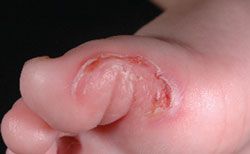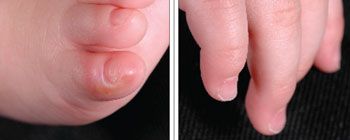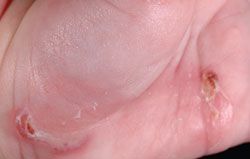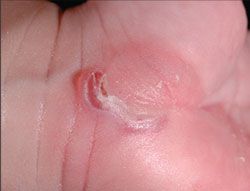Blisters on Infant's Hands and Feet
Case: The parents of this 5-month-old boy are concerned about recurring eruptions of blisters on the infant’s hands and feet. What question could you ask the parents that might quickly define the condition for you?
Case: The parents of this 5-month-old boy are concerned about recurring eruptions of blisters on the infant’s hands and feet. What question could you ask the parents that might quickly define the condition for you?



(Answer on next page)

This child has epidermolysis bullosa simplex. Epidermolysis bullosa (EB) encompasses a large number of genetically transmitted skin disorders characterized by abnormalities in the structure of the epidermis, the dermis, or the dermoepidermal junction that result in blistering caused by mechanical friction. The clinical manifestations of these disorders vary from minor blisters to mutilating and even life-threatening blistering and scarring of the skin and other epithelial structures. In a newborn, it is often difficult to distinguish between the variants of EB without a skin biopsy; however, later in infancy, the clinical presentation is usually sufficient to enable a clinician to be comfortable with the diagnosis. Confirmation of the specific variant present in a particular patient requires that unique investigations be performed on the skin. I recommend that clinicians contact a pediatric dermatologist to determine who can perform these investigations.
EB simplex. In the disorder known as EB simplex, the structural defect is within the epidermis; it results from an inherited defect in the keratin filaments (keratins 5 and 14) that are necessary to the structural integrity of the epidermis. The blisters of EB simplex occur within the lower areas of the epidermis and are similar to the friction blisters seen in a child with normal skin.

There are at least 10 variants of the genetic mutation that underlies EB simplex; the majority of these are autosomal dominant. This child has the Koebner variant, a common variant that is autosomal dominant and that usually first manifests in infancy. In the Koebner variant of EB simplex, there is a generalized fragility of the skin; however, the predilection for blistering is seen mainly on the hands and feet. The oral mucosa is not normally involved; if it is, oral manifestations are generally mild. The blisters of EB simplex, Koebner variant, heal quickly without scarring unless they become secondarily infected.
Therapy. There is no specific therapy for EB simplex other than the obvious measures to reduce frictional trauma and prevent secondary infection. The blisters of EB simplex are usually more frequent in the summer, and choosing proper footwear for affected children is always an important consideration. This is a lifetime issue, and I generally start avocation and occupational counseling at the time of diagnosis.
Recognize & Refer: Hemangiomas in pediatrics
July 17th 2019Contemporary Pediatrics sits down exclusively with Sheila Fallon Friedlander, MD, a professor dermatology and pediatrics, to discuss the one key condition for which she believes community pediatricians should be especially aware-hemangiomas.